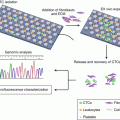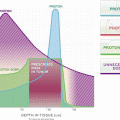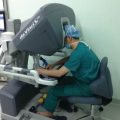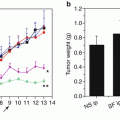, Jia Wei1, Lijing Zhu1 and Wenjing Hu1
(1)
The Comprehensive Cancer Centre of Drum Tower Hospital, Medical School of Nanjing University and Clinical Cancer Institute of Nanjing University, Nanjing, 210008, China
Despite the fact that numerous advances have been made toward the development of new tumor screening methods, as well as surgical skills and systematic chemotherapy regimens, the overall prognosis for advanced gastric cancer patients remains dismal. This is especially true for patients with late-stage disease. The 5-year survival rate for patients with metastatic gastric cancer remains around 10%. Thus, improvements in the management of gastric cancer, specifically through treatment with targeted therapeutic agents, are urgently required. With advances in our understanding of the biology of malignancy and the molecular evolution of gastric cancer, the potential for targeted therapy has begun to emerge [1]. However, only a limited number of molecular-targeted drugs have been approved at this point in time. Tumor cells possess unique characteristics that enable them to drive the disease to the malignancy stage, including immortality, the ability to infiltrate other tissues, and promote changes in the tumor microenvironment. Thus, the molecular targets of gastric cancer should include not only genetic mutations of the tumor cells but also the factors that enable the alteration of the tumor stroma, such as tumor angiogenesis, inflammatory cell infiltration, extracellular matrix, and others [2].
5.1 Novel Comprehensive Classification of Gastric Cancer
Different types of gastric cancer are traditionally subdivided by histologic subtype via the World Health Organization (WHO) or Lauren classifications [3], with each subtype having distinct clinical and epidemiologic features. In the case of Lauren classifications, intestinal gastric cancer tends to be associated with Helicobacter pylori infection, tends to occur in the antrum, and is found to often develop from intestinal metaplasia. Diffuse gastric cancers, on the other hand, are more poorly differentiated. These cancers tend to be found in younger patients and are associated with a poorer prognosis. The WHO classification divides gastric cancers based on their resemblance to a metaplastic intestinal tissue [4]. While these classifications are different, both help little in the selection for the most appropriate treatment for advanced gastric cancer patients.
Genetic alterations are the main typical feature of cancer cells, playing crucial roles in carcinogenesis and tumor progression [5]. Current research is still being carried out to understand the detailed mechanisms of tumor development associated with gene amplification, mutation, or translocation. However, quite a few aberrant genes have been identified as valid targets for the treatment of cancer in the clinic. Distinguishing driver oncogenes from other coexisting passenger gene alterations and subsequently blocking the activated signaling transduction have been a critical strategy for the development of molecular-targeted therapeutics. In order to facilitate the discovery and validation of “driver” genes, patient-derived specimen-based molecular analysis techniques and in vivo disease models have been widely used. Deng et al. [6] screened 233 gastric cancer patients and identified five distinct gastric cancer patient subgroups. These subgroups were defined by the signature genomic alterations of FGFR2 (9% of tumors), KRAS (9%), EGFR (8%), ERBB2 (7%), and MET (4%). They proposed that at least 37% of gastric cancer patients could be potentially treated with receptor tyrosine kinase-directed therapies. This was considered to be the first detailed molecular map of genomic alterations in gastric cancer, a step bringing the field closer to the development of targeted treatment. The development of high-throughput, multi-platform sequencing has led to increased efficacy and accessibility of genomic sequencing, in turn driving the development of classification systems based not only on histopathology but also on molecular features. Currently, several studies have provided insight into the molecular basis of gastric cancer, enabling improved molecular classification of gastric cancers. In 2014, a comprehensive molecular classification of gastric cancer was carried out by the Cancer Genome Atlas (TCGA) project, and they identified a series of genomic alterations which were expected to provide insight into potentially novel therapeutic targets [7]. This study carried out sequencing of 295 gastric cancer patients and resulted in the patients being clustered into four groups, which included Epstein-Barr virus (EBV)-positive tumors (9%), tumors with microsatellite instability (MSI) (22%), genomically stable tumors (20%), and those with chromosomal instability (50%). A similar research study carried out by the Asian Cancer Research Group (ACRG) analyzed a panel of 300 gastric tumor tissues. For each tumor, gene expression profiling, targeted gene sequencing, and genomic copy number microarrays were carried out [8]. Following the profiling of 251 gastric cancer tissues, the authors then further divided gastric cancers into four groups, MSS/EMT (microsatellite stable/epithelial-to-mesenchymal transition), which encompassed the outliers on the EMT distribution, MSI, MSS/TP53+, and MSS/TP53−. TCGA and ACRG classifications showed both similarities and differences. In the two classification systems, a MSI subtype with high mutation frequency shared similar genomic characteristics and the best prognosis. TCGA that is genomically stable, EBV+, and CIN subtypes were enriched in but not identical to ACRG MSS/EMT, MSS/TP53+, and TP53–, respectively. Due to the different frequency of CDH1 and RHOA mutations, the TCGA GS subtype was found to not be equivalent to the ACRG MSS/EMT subtype. Besides, MSS/TP53 was not found to cover TCGA EBV subtype, as only 12/18 EBV+ tumors were present in the MSS/TP53+ group [9]. Once trastuzumab, a drug that targets overexpressed HER2, was approved as the first targeted drug against advanced/metastatic gastric cancer in 2010, research efforts have almost failed on the development of other promising targets, including c-Met, EGFR, IGFR, PI3K, mTOR, and others. Clinical trials were carried out to identify promising therapeutics, while abortive attempts find a number of candidates not so satisfactory (Table 5.1). While the molecular classification of gastric cancer greatly helped to provide insight into the carcinogenesis and progression of gastric cancer and identify patients having different genetic and epigenetic alterations resulting in a different prognosis, few remarkable treatment targets have been identified for molecular-targeted therapy.
Table 5.1
Completed phase III clinical trials of targeted therapies in gastroesophageal adenocarcinoma
Agents | Targets | Type | Chemotherapy | Study | OS | PFS |
|---|---|---|---|---|---|---|
Trastuzumab | HER2 | Recombinant humanized mAb | Capecitabine/fluorouracil + cisplatin | ToGA | 13. 8 vs. 11.1 | 6.5 vs. 5.5 |
Lapatinib | EGFR, HER2 | Tyrosine kinase inhibitor | Capecitabin e + oxaliplatin | TRIO-013/LOGIC | 12.2 vs. 10.5 | 6.0 vs. 5.4 |
Lapatinib | EGFR, HER2 | Tyrosine kinase inhibitor | Paclitaxel | TyTAN | 11 vs. 8.9 | 5.4 vs. 4.4 |
Cetuximab | EFGR | Humanized mAb | Cisplatin + capecitabine | EXPAND | 9.4 vs. 10.7 | 4.4 vs. 5.6 |
Panitumumab | EFGR | Humanized mAb | Epirubicin + oxaliplatin+ capecitabine | REAL-3 | 8.8 vs. 11.3 | 6.0 vs. 7.4 |
Rilotumumab | HGF | Humanized mAb | Epirubicin + cisplatin + capecitabine | RILOMET-1 | 9.7 vs. 11.1 | 5.1 vs. 4.2 |
Onartuzumab | c-Met | Humanized mAb | mFOLFOX6 | METGastric | 11 vs. 9.7 | − |
Ramucirumab | VEGFR2 | Humanized mAb | Paclitaxel | RAINBOW | 9.6 vs. 7.4 | 4.4 vs. 2.9 |
Bevacizumab | VEGF | Humanized mAb | Capecitabine + Cisplatin | AVAGAST | 12.1 vs. 10.1 | 5.3 vs. 6.7 |
Apatinib | VEGFR2 | Tyrosine kinase inhibitor | − | Phase III study of apatinib tablets in the treatment of advanced or metastatic gastric cancer | 6.5 vs. 4.7 | − |
Everolimus | mTOR | Inhibitor | − | GRANITE | 5.4 vs. 4.3 | 1.7 vs. 1.4 |
The tumor microenvironment, which is comprised of immune cells, tumor cells, stromal cells, and extracellular matrix, is considered to be the primary battleground during the neoplastic process, fostering the proliferation, survival, and migration of tumor cells. Current classification of malignancy relies highly on not only the information of tumor cells but also the tumor microenvironment, including tumor vessels and the tumor immunity status [10]. Following years of research efforts, it was discovered that tumors can not only survive and disseminate but can more importantly mimic certain signaling pathways of the immune system to propagate conditions that favor tumor immune tolerance. In addition, focused anti-angiogenesis was found to fail as a treatment, demonstrating the sustained anticancer effect. Thus, multiple pathways within the tumor microenvironment must be co-targeted in order to release the full effector function of tumor-specific immune cells.
5.2 Targeting the Driver Oncogenes of Tumor Cells
5.2.1 HER2
HER2, also known as ERBB2 (ErbB2 receptor tyrosine kinase 2), is a member of the human epidermal growth factor receptor family, and almost 15–20% of gastric adenocarcinomas have shown HER2 amplification [11]. Clinically, HER2-positive gastric cancer is termed with a score of 3+ using immunohistochemistry (IHC) method or positive fluorescence in situ hybridization (FISH) (HER2 to CEP17 ratio, 2:2). In contrast to breast cancer, using HER2 as a predictor for prognosis in gastroesophageal cancer is contradictory, with some studies showing an association between HER2 overexpression and poor overall survival (OS) and other studies showing no significant relationship with OS [12, 13].
Trastuzumab (Herceptin), a recombinant humanized IgG1 monoclonal antibody, binds to the HER2 receptor, resulting in an elimination or reduction in receptor activity. This weakens subsequent signaling events involving proteins such as protein kinase B (PKB) and signal transducer and activator of transcription 3 (STAT3). In another way, trastuzumab has been shown to induce antibody-dependent cytotoxicity (ADCC) which resulted in cell cycle disorders [14]. Trastuzumab was initially approved in HER2-overexpressing metastatic breast cancer patients and, later, in the postoperation adjuvant treatment of breast cancer. When combined with chemotherapy, it was shown to significantly prolong OS compared with chemotherapy treatment alone. Based on the positive results seen with breast cancer patients and the high prevalence of HER2 amplification and overexpression associated with gastroesophageal cancer, a study using trastuzumab for the treatment of gastric cancer patients was carried out. The ToGA (Trastuzumab for Gastric Cancer) trial was a multicenter, phase III trial which assigned advanced or metastatic gastroesophageal cancer patients with positive HER2 in tumor cells to receive 5-fluorouracil or capecitabine and cisplatin treatments, with or without trastuzumab, randomly as the first-line treatment [15]. After a primary screening, a total of 594 patients were randomly assigned to the two different groups. The patients who received trastuzumab were found to have a higher overall response rate (47% vs. 35%; p = 0.0017) and a longer median PFS (6.7 vs. 5.5 months; p = 0.0002) and median OS (13.8 vs. 11.1 months; p = 0.0046). Based on the results from the above study of ToGA, trastuzumab treatment with fluoropyrimidine and cisplatin was considered as the standard first-line treatment for HER2-positive gastric cancer patients.
Following the established paradigm for HER2-positive breast cancer treatment, small molecule inhibitors of HER2 were subsequently analyzed in advanced gastric cancer. Lapatinib (Tykerb) is known to bind the intracellular tyrosine kinase domains of epidermal growth factor receptor (EGFR) and HER2, subsequently blocking autophosphorylation and downstream signaling. Similar with what was observed with metastatic breast cancer, lapatinib treatment appeared to be less effective than trastuzumab treatment in gastric cancer patients. Based on the preclinical data and a 9% response rate in a phase II trial of single-agent lapatinib in advanced gastroesophageal adenocarcinoma [16], two phase III trials of lapatinib treatment for HER2-positive gastric cancer patents were launched. These two trials differed in the status of the previous treatment. The TRIO-013 (Translational Research in Oncology)/LOGiC (Lapatinib Optimization Study in the HER2-Positive Gastric Cancer) trial was a multicenter, double-blinded, phase III trial which randomly assigned patients with previously untreated HER2-positive advanced gastroesophageal cancers to groups that received Xelox chemotherapy plus either lapatinib treatment or a placebo control [17]. While patients in the lapatinib treatment arm of the study were observed to have a significantly higher response rate compared with the control group (53% vs. 39%; p = 0.0031), this study did not reach its primary endpoint, as there was no significant improvement in OS detected (median OS 12.2 vs. 10.5 months; HR = 0.91; p = 0.3492). The subgroup analyses revealed an OS improvement of lapatinib treatment in both younger patients (12.9 vs. 9.0 months, HR = 0.69; 95% CI, 0.51–0.94, p = 0.0141) and Asian patients (16.5 vs. 10.9 months, HR = 0.68; 95% CI, 0.48–0.96, p = 0.0261). It should be noted that there was no correlation observed between the IHC status of HER2 and survival. The TyTAN (Lapatinib [Tykerb] with Paclitaxel [Taxol] in Asian ErbB2+ [HER2+] Gastric Cancer Study) study was a phase III clinical trial where paclitaxel was given as a treatment with or without lapatinib as the second-line treatment of advanced HER2-positive gastric cancer in Asian population [18]. The median OS was not found to be different between the two arms of the study (11.0 vs. 8.9 months; HR = 0.84; p = 0.1044). Subgroup analyses identified a significant OS benefit for patients with HER2 IHC 3+ (14 vs. 7.6 months; HR = 0.59; p = 0.0176). Specifically, the biomarker for determining enrollment in the two trials was the presence of HER2 amplification, as identified with FISH-positive samples, regardless of HER2 expression levels observed with IHC. Gastric cancer patients exhibiting more amplification of HER2 were found to be more likely to benefit from anti-HER2 treatment. Interestingly, in a recent series of patients with metastatic gastric cancer that were treated with trastuzumab alongside chemotherapy, a higher HER2 to CEP17 ratio (≥ 4.7) in FISH detection was identified to be the optimal cutoff as a prediction response for HER2-directed therapy [19].
Given the successful results observed with trastuzumab, novel HER2-targeted therapeutics are currently being evaluated in both of the first- and second-line settings. Pertuzumab, which is a monoclonal antibody that block the heterodimerization of HER2 and other HER proteins, is currently being investigated in a first-line therapy to be used in conjunction with trastuzumab and chemotherapy in the phase III trial, JACOB (A Study of Perjeta [Pertuzumab] in Combination with Herceptin and Chemotherapy in Patients with HER2-Positive Metastatic Gastroesophageal Junction or Gastric Cancer) trial (ClinicalTrials.gov ID: NCT01774786) [20]. Pertuzumab was shown to inhibit the ligand-induced dimerization of HER2. This suggests that a broader range of individuals would benefit from pertuzumab, which needs further verification. Trastuzumab emtansine (T-DM1) is an antibody drug conjugate that combines trastuzumab with emtansine, a cytotoxic agent similar to taxane. Recently, T-DM1 was evaluated in HER2-positive gastric cancer since it has been approved in the treatment of trastuzumab-refractory metastatic breast cancer. In addition, phase II/III adaptive trial (A Study of Trastuzumab Emtansine Versus Taxane in Patients With Advanced Gastric Cancer) examined the efficacy of T-DM1 compared to taxane treatment as the second-line therapy for advanced HER2-positive gastroesophageal cancer patients (ClinicalTrials.gov ID: NCT01641939) [21]. The final results of this trial indicated a possible benefit from higher dose of T-DM1 (3.6 mg/kg). Afatinib is a second-generation irreversible tyrosine kinase inhibitor, both of EGFR and HER2, and is thought to potentially show greater efficacy over lapatinib. A phase II study of afatinib comparing to paclitaxel monotherapy in patients with trastuzumab-refractory HER2-positive advanced gastric cancer is currently underway (ClinicalTrials.gov ID: NCT01522768).
5.2.2 EGFR
The epidermal growth factor receptor (EGFR) is a receptor tyrosine kinase within the HER family. EGFR has been demonstrated to be amplified in 10–15% of gastric cancer patients. However, a higher proportion (27–55%) of gastric cancer patients have been shown to overexpress EGFR [22]. To date, few trials of EGFR-directed agents of monotherapy or in combination with chemotherapy have shown an improvement in outcomes. A few of phase III studies have focused primarily on the use of monoclonal antibodies targeting EGFR (such as cetuximab and panitumumab), while some smaller phase II trials have focused on studying the activity and efficacy of EGFR tyrosine kinase inhibitors (such as gefitinib).
Cetuximab (C225) is a humanized IgG1 monoclonal antibody that has been shown to bind specifically to the extracellular domain of EGFR and competitively inhibits the binding of natural ligands to EGFR, thereby blocking the ligand-induced phosphorylation of the tyrosine kinase domain of EGFR. Cetuximab has been shown to downregulate the expression of cell surface receptors, weaken receptor-mediated signaling, and kill tumor cells via an ADCC effect. The EXPAND ( Erbitux (cetuximab) in combination with Xeloda (capecitabine) and cisplatin in advanced esophagogastric cancer) study was a multicenter, phase III trial which treated subjects with cisplatin and capecitabine, with or without cetuximab among patients with previously untreated advanced or metastatic gastroesophageal adenocarcinomas [23]. This study showed no differences in OS or PFS between the two arms (median OS 9.4 vs. 10.7 months; HR = 1.0; p = 0.95 median PFS 4.4 vs. 5.6 months; HR = 1.09; p = 0.32). Exploratory analysis showed a tendency toward survival benefit for patients that received a combination treatment of both cetuximab and chemotherapy in the EGFR-overexpressing group. Multivariate analysis indicated that mutations in the KRAS and PIK3CA act as poor prognosis factors. Similarly disappointing results were reported from the REAL-3 (Randomized Trial of EOC ± Panitumumab for Advanced and Locally Advanced Esophagogastric Cancer) trial. This trial randomly assigned patients with previously untreated advanced gastroesophageal cancer to receive a EOC (epirubicin, oxaliplatin and capecitabine) chemotherapy with or without panitumumab, a fully human monoclonal antibody targeted against EGFR. The addition of panitumumab treatment to EOC not only failed to improve outcomes but was also observed to result in a detrimental effect on OS (8.8 vs. 11.3 months; HR = 1.37; 95% CI, 1.07–1.76; p = 0.013) [24]. The tendency toward shorter survival could be attributed to inadequate chemotherapy drug dosages and an accelerated cancer progression following drug withdrawal. An additional phase III trial comparing nimotuzumab + irinotecan vs. placebo + irinotecan, ENRICH, is currently ongoing. The aim of this study is to assess the activity of these treatment regimens in advanced gastric cancer patients with EGFR IHC 2+ or 3+(ClinicalTrials.gov ID: NCT01813253).
Trials that have studied the efficacy of EGFR tyrosine kinase inhibitors have also shown modest results. The objective response rates ranged only from 0 to 11% [25]. The fact that these trials failed in the end suggests that EGFR may not be the primary oncogenic driver in advanced gastric cancer. It should be noted that all EGFR-directed trials were performed using unselected patient populations, which could explain some of the disappointing results. Therefore, the identification of predictive markers of anti-EGFR treatment outcomes in order to determine a population that would be the most likely to benefit from this therapy is crucial for understanding the true therapeutic efficacy of these treatments. Further evaluation of EGFR inhibitors should therefore be warranted in a carefully selected patient population, primarily choosing patients with EGFR-amplified gastric cancer.
5.2.3 HGF Pathway
Over activation of the MET oncogene and hepatocyte growth factor (HGF) pathways has been demonstrated to promote tumor growth and metastasis in gastric cancer patients. While MET amplification is identified only in approximately 4–6% of gastric cancer patients, MET expression has been reported in almost more than a half of gastric cancers. Trials evaluating the clinical efficacy of monoclonal antibodies against HGF (rilotumumab) and the MET receptor (onartuzumab) were carried out recently without impressive results.
The phase III trials RILOMET-1 (phase III, randomized, double-blinded, multicenter, placebo-controlled trial of rilotumumab plus epirubicin, cisplatin, and capecitabine as first-line therapy in patients with advanced MET-positive gastric or gastroesophageal junction cancer) and RILOMET-2 for Asian patients only were initiated based on the positive results stemming from a randomized phase II trial of rilotumumab treatment in patients with MET-overexpressing gastroesophageal cancer [26–28]. However, both studies are closed due to toxicity concerns. The RILOMET-1 trial randomly assigned untreated advanced MET-positive gastroesophageal cancer patients to receive ECX with or without rilotumumab treatment. There were 600 patients that were randomly assigned after screening approximately 1500 patients and identifying 1043 patients as MET-positive by IHC methods. Similar to the clinical trial assessing panitumumab, RILOMET-1 identified a detrimental effect on OS at the addition of rilotumumab treatment to chemotherapy (OS 9.6 vs. 11.5 months; HR = 1.37; p = 0.0016), resulting in an early termination of the trial. Correlative biomarker studies are currently still underway. However, neither MET overexpression, as determined by IHC, nor MET amplification, as determined by FISH, was associated with more positive outcomes in the rilotumumab arm, surprisingly. The METGastric (A Study of Onartuzumab in Combination With mFOLFOX6 in Participants with Metastatic HER2-Negative and MET-Positive Gastroesophageal Cancer) trial studied the efficacy of onartuzumab, a monoclonal antibody targeted against the MET receptor, in patients with untreated, advanced MET-positive gastroesophageal cancer. The study was designed such that 800 patients would be randomly assigned to receive FOLFOX plus onartuzumab or a placebo treatment. In this trial, the addition of onartuzumab to first-line mFOLFOX6 chemotherapy in the intent to treat or MET 2+/3+ populations did not significantly improve clinical benefits [29]. A total of 562 patients were enrolled prior to the closure of the METGastric study due to the sponsor decision. For the entire study population, onartuzumab was found to fail to improve outcomes (median OS 11.3 vs. 11.0 months; HR = 0.82; p = 0.244). In the case of patients that possessed MET-overexpressing tumors, as determined by IHC (2+ and 3+), there was a trend observed toward improved OS in the onartuzumab arm of the study (11.0 vs. 9.7 months; HR = 0.64; p = 0.062) [30]. Biomarker-based analyses should focus on both the reason underlying these negative results and the method to identify subgroups that may respond to MET inhibition.
Unlike monoclonal antibody treatments, potentially promising results were recently achieved using a highly selective MET small molecule inhibitor, AMG 337. A pilot trial was described that a dramatic response for AMG337 was observed in13 patients with MET-amplified gastroesophageal cancer at the 2015 American Society of Clinical Oncology Gastrointestinal Cancers Symposium. AMG 337 monotherapy made eight patients (62%) achieve either a partial or complete response. Given these encouraging results, a phase II study of AMG 337 in MET-amplified gastroesophageal cancer patients and patients with other solid tumors is currently in process (ClinicalTrials.gov ID: NCT02016534).
5.2.4 FGFR2
Fibroblast growth factor receptor 2 (FGFR2) is a receptor tyrosine kinase that plays pivotal roles in cell proliferation, differentiation, and migration. FGFR2 amplification has been shown to occur in less than 10% of gastric adenocarcinomas and is associated with lymphatic invasion and a poor clinical prognosis [31, 32]. A biomarker-driven clinical trial that investigated the efficacy of FGFR2 inhibition was carried out recently. The SHINE study was a randomized phase II trial that compared the FGFR inhibitor, AZD4547, to paclitaxel in a second-line setting in FGFR2-amplified advanced gastric cancer patients (ClinicalTrials.gov ID: NCT01457846). A total of 71 patients with FGFR2 polysomy or gene amplification were randomized to receive either AZD4547 or paclitaxel treatment. The median PFS was 1.8 months for patients treated with AZD4547 vs. 3.5 months for patients treated with paclitaxel. Subsequently, exploratory biomarker analysis revealed marked intra-tumor heterogeneity of FGFR2 amplification, with four out of seven tumors tested showing amplification in 20% of the tumor section. Furthermore, only 21% of FGFR2-amplified tumors were found to possess high FGFR2 expression levels. While the correlation of heterogeneity and FGFR2 expression with response to AZD4547 were not reported in this study, both of these reasons could explain part of the lack of efficacy observed with FGFR2 inhibition. Another phase II clinical trial to explore the activity of the FGFR2 inhibitor, dovitinib, in the second- and third-line setting is still recruiting patients (ClinicalTrials.gov ID: NCT01719549). Further biomarker studies to identify biomarkers that could better predict the response or resistance to FGFR inhibition will be essential in future studies.
Stay updated, free articles. Join our Telegram channel

Full access? Get Clinical Tree







